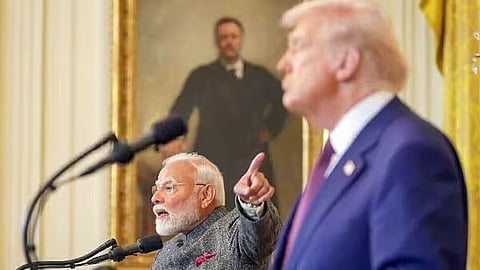

Donald Trump’s decision to impose a 25 percent tariff on Indian imports, along with an unspecified penalty, has triggered concerns over a potential blow to India’s economic growth and export competitiveness.
In a post on his Truth Social platform on Wednesday, Trump said the additional penalty—beyond the 25 percent tariff—would take effect from August 1. He justified the move by accusing India of continuing to buy Russian oil and weapons “at a time when everyone wants Russia to stop the killing in Ukraine.”
The precise details of the penalty remain unclear, but economists say its size and scope will be critical to assessing the full impact on India’s economy.
“The tariff and penalty now proposed by the US are higher than anticipated, and will likely act as a headwind to India’s GDP growth,” BBC quoted Aditi Nayar, chief economist at ratings agency ICRA, as saying. “The extent of the downside will depend on the magnitude of the penalty.”
ICRA had already downgraded its GDP forecast for India for the current financial year from 6.5 percent to 6.2 percent, citing risks from higher US trade barriers.
Japanese brokerage Nomura described the measures as “growth negative”, estimating that they could shave 0.2 percentage points off India’s GDP.
Markets reacted swiftly. Indian stock indices opened in the red, reflecting investor disappointment. “The market had priced in some form of tariff agreement, considering the strategic alignment between the two countries,” said Nilesh Shah, a fund manager.
Over recent months, India and the US had held multiple rounds of negotiations to finalise a bilateral trade pact. New Delhi had even lowered tariffs on high-profile US exports such as Bourbon whiskey and large motorcycles. However, Trump has remained fixated on reducing the $45 billion trade deficit the US runs with India.
India’s commerce ministry said it is evaluating the implications of Trump’s announcement. In a statement, the ministry reaffirmed its commitment to a mutually beneficial agreement but stressed that “the welfare of our farmers, entrepreneurs, and MSMEs” remained paramount—an apparent reference to sticking points in agriculture and other politically sensitive sectors.
Trade experts say the new tariff regime could hurt several Indian sectors, including marine products, pharmaceuticals, textiles, leather and automobiles—areas where Indo-US trade has traditionally been robust.
“India is now at a relative disadvantage to competitors like Vietnam and China, who recently negotiated lower US tariff rates,” said Rahul Ahluwalia of the Foundation for Economic Development. “This undermines expectations that India would benefit from supply chain shifts in sectors like textiles.”
Recent trade talks between the US and China saw tariffs on Chinese goods fall from 145 percent to 30 percent. Trump also struck a deal with Vietnam earlier in July, agreeing to a 20 percent tariff—much lower than the 46 percent initially proposed in April.
“If these higher tariffs persist, exporters will be forced into price renegotiations with US buyers, which could compress their margins and hurt competitiveness,” said Ajay Sahai, head of a federation of Indian exporting organisations.
Meanwhile, the opposition Congress party launched a scathing political attack. In a post on X, the party said that despite Prime Minister Narendra Modi’s overtures to Trump—including a 2019 campaign-style rally in the US—Trump had responded with punitive measures, calling it “a catastrophic failure of foreign policy”.
Mark Linscott, former US trade representative and senior adviser at the US India Strategic Partnership Forum, said Trump's decision to link trade talks with India’s ties to Russia had “complicated” the process.
“They’ve introduced an entirely new dimension to the negotiations. It’s unclear how those geopolitical issues can be folded into a trade package,” he said.
Since the start of the war in Ukraine, India has defended its strategic ties with Russia, including ongoing purchases of discounted crude oil. It argues that as a developing economy heavily reliant on energy imports, it must secure affordable supplies to protect its poorest citizens.
India has also steadily reduced its dependence on Russian arms, though the transition is gradual.
Despite Trump’s repeated description of India as a “good friend”, he has long railed against what he calls India’s “unacceptably high tariffs”. On Thursday, he wrote: “I don’t care what India does with Russia. They can take their dead economies down together. We’ve done very little business with India—their tariffs are among the highest in the world.”
Despite the latest escalation, negotiations between the two countries are expected to continue through August. A US delegation is likely to visit India later next month to restart discussions on a comprehensive deal.
There is still some optimism that the announced tariffs may be rolled back—or at least moderated—as part of a final agreement. The two sides have reportedly set a deadline for autumn to conclude the negotiations.
“Even in the best-case scenario, we are likely looking at tariffs in the 15–20 percent range,” said Nomura, “which is disappointing given the advanced stage of the talks.”
While India’s domestic economy is less dependent on exports compared to many of its Asian peers, analysts say the tariff shock could increase pressure on the Reserve Bank of India to ease interest rates further to cushion growth.
With bilateral trade with the US currently at $190 billion, and both nations targeting $500 billion over the coming years, observers say the geopolitical stakes remain high for resolving the dispute—soon.